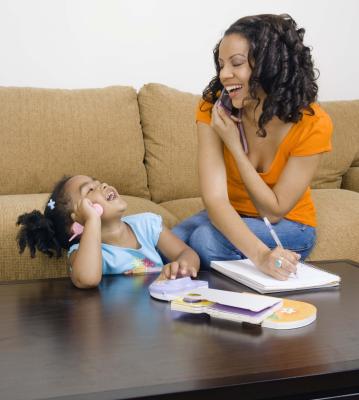Nothing is more exciting than to hear your baby start forming words, especially when she holds her arms out to you, while saying, “Mama!” All kids learn to speak at their own pace, but you can look to general guidelines and milestones to determine whether your baby is on track. Language development, which refers to speech and nonverbal communication, is one measure of normal infant development.
Guidelines
MayoClinic.com offers some general guidelines to show you what babies can do by a certain age. By the end of the third month, your baby makes cooing sounds and seems to recognize your voice. After six months, your baby makes gurgling sounds and may make sounds, such as “ba, ba, ba.” After a year, your baby tries to imitate some words, such as “mama,” “dada,” and “uh-oh.” Your baby can also understand you, such as when you say “no” or give simple instructions, such as “Eat your cereal, please.” At 18 months, your baby can point to an object that you name, recognize names of people she knows and know body parts. She can say eight to 10 words. By the time your child is 2 years old, she can ask for foods by name, say things like “more, please” or “mine.” She can ask if you are going “bye-bye.” She can say about 50 words but may be difficult to understand.
Encourage Language
Ways to encourage language development are to talk to your baby. You don’t have to give a soliloquy, but talk to your baby like the way the chefs on cooking shows do. They describe what they are doing while they do it. If you are giving a bath, for example, describe what you are doing. “I’m putting soap on the washcloth, and I’m going to wash your tummy.” You can sing songs at this time or ask questions. You can indulge in some baby talk, but your child will learn to speak from hearing you speak normally. Babies love it when you read to them. Babies simply like the sound of your voice, while toddlers enjoy the stories and pictures, too. Always listen when your baby talks to you. Not only does this encourage verbalization in your baby, it sets the stage for your ongoing relationship.
Rhythm and Rhymes
Babies love rhythm and rhymes. When you read to yours, nursery rhymes and nonsense words, like the kind Dr. Seuss uses, are typically great fun for babies to hear. Babies may bounce up and down when you read, “Humpty Dumpty sat on the wall.” Nursery rhymes and rhythms help your child enjoy and develop language, according to Dr. Alice Sterling Honig in an article she wrote for “Scholastic” magazine.
Behind on Development
The BabyCenter lists some signs you can look for that may indicate a problem. You should be concerned if your baby doesn’t make any sounds or eye contact with you by six months. Take your baby to the doctor if he hasn’t said any words by 15 months and can’t point to any body parts. If you can’t understand him at all by 18 months, that could signal a problem. Another cause for concern is if by 2 years of age your child rarely speaks, drops consonants from words and only uses one word with no combinations.
Your Doctor
If your child is behind on language development, talk to your doctor. Speech delays could be due to hearing loss or an oral impairment. Your doctor may recommend a hearing specialist or a pediatric speech-language pathologist. Even if your child is behind, continue to encourage language by reading to her, singing songs, teaching hand gestures for certain objects and by asking questions and acknowledging any response, recommends MayoClinic.com.





